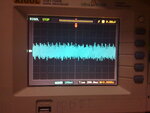masab_ahmad
Member level 1
Hi!
I am making an ECG circuit from this link below, and i've replaced the AD620 with an AD622 instrumentation amplifier. I've also replaced the OP97 op amp with an LM2904. The problem is that i'm not getting any signal from the electrodes and from the output of this circuit (i should have got something). I've attached a photo of the output.
https://www.radiolocman.com/shem/schematics.html?di=47010
These guys (link attached below) also employed the same circuit (and replaced the AD620 with an AD622), and they got a noisy ecg signal straight from their electrodes. So is it possible that my electrodes/skin contacts are faulty?
courses.engr.illinois.edu/ece445/projects/.../project17_presentation.ppt
i also made a similar circuit using a PSoC (which was working according to its author), only to get similar results....
I am making an ECG circuit from this link below, and i've replaced the AD620 with an AD622 instrumentation amplifier. I've also replaced the OP97 op amp with an LM2904. The problem is that i'm not getting any signal from the electrodes and from the output of this circuit (i should have got something). I've attached a photo of the output.
https://www.radiolocman.com/shem/schematics.html?di=47010
These guys (link attached below) also employed the same circuit (and replaced the AD620 with an AD622), and they got a noisy ecg signal straight from their electrodes. So is it possible that my electrodes/skin contacts are faulty?
courses.engr.illinois.edu/ece445/projects/.../project17_presentation.ppt
i also made a similar circuit using a PSoC (which was working according to its author), only to get similar results....
